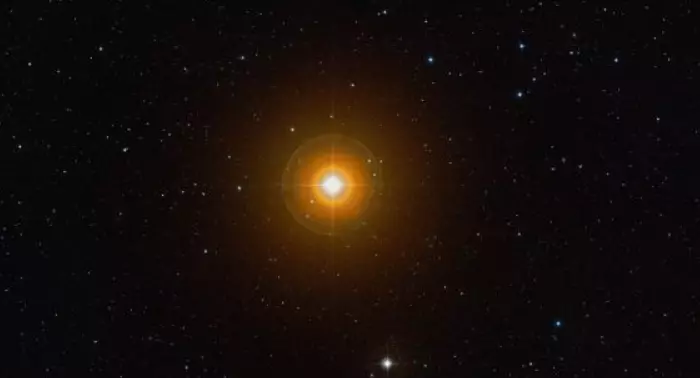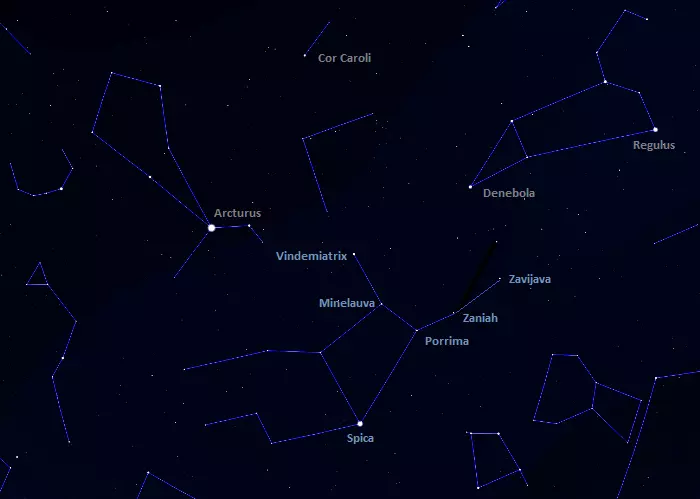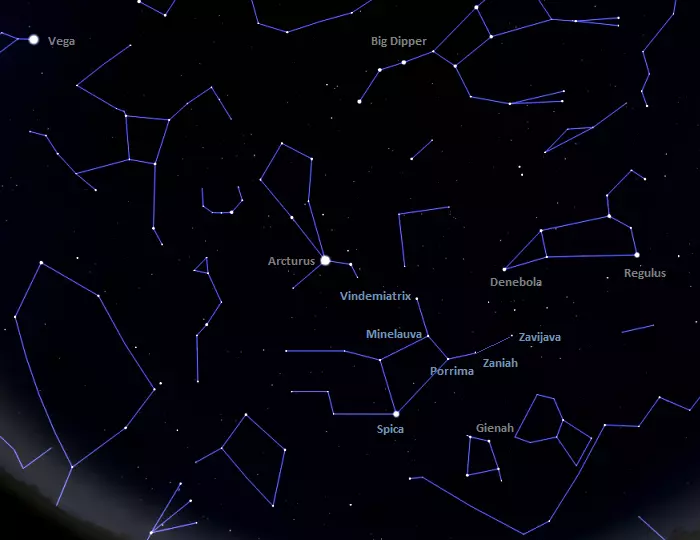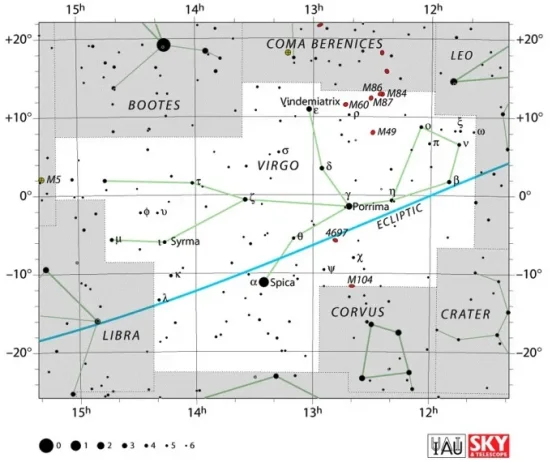Minelauva, Delta Virginis (δ Vir), is a red giant star located 198 light-years away in the constellation Virgo. With an apparent magnitude that varies between 3.32 and 3.40, it is the fifth brightest star in Virgo, after Spica, Porrima, Vindemiatrix, and Heze. Minelauva is one of the bright stars that form the Y of Virgo, an asterism commonly used to find the galaxies of the Virgo Cluster.
Star type
Minelauva is a red giant of the spectral type M3 III. It has a mass of about 1.4 solar masses and a surface temperature of 3,999 K. As it evolved away from the main sequence, the star expanded to a size of 48 solar radii. It is 468 times more luminous than the Sun.
Delta Virginis is classified as a semiregular variable. Its brightness varies between magnitudes 3.32 and 3.40. Semiregular variables are typically giant and supergiant stars of late spectral types whose brightness fluctuates with regular periods. The brightness of Minelauva varies due to pulsations of the giant star’s outer envelope. The variations are caused by multiple periods of pulsation, including 13 days, 17.2 days, 25.6 days, 110.1 days, and 125.8 days.

Minelauva (Delta Virginis), image: Wikisky
Minelauva may form a binary system with an orange dwarf that lies at an angular separation of 80 arcseconds. The physical distance between the pair may be over 5,000 astronomical units. If the stars are physically related, they have an orbital period of more than 200,000 years. However, they may merely form a line-of-sight pair.
Facts
Minelauva is a high-velocity star. It has a peculiar velocity of over 30 km s-1 relative to the motion of other nearby stars.
Minelauva forms the Y of Virgo with Spica (Alpha Virginis), Porrima (Gamma Virginis), Vindemiatrix (Epsilon Virginis), Zaniah (Eta Virginis), and Zavijava (Beta Virginis). Spica appears at the base of the crooked Y, while the other stars form the bowl. Minelauva and the brighter Vindemiatrix point in the direction of the faint constellation Coma Berenices, while Zaniah and Zavijava stretch towards Regulus, the brightest star in Leo. The asterism is commonly used to locate the Virgo Cluster of galaxies, whose center appears halfway between Vindemiatrix in Virgo and Denebola in Leo.

The Y of Virgo, image: Stellarium
Name
The name Minelauva (pronunciation: /ˌmɪnəˈlɔːvə/) comes from the Arabic phrase min al-ʽawwāʼ, meaning “in the lunar mansion of awwa.” The name Al ʽAwwāʼ (the Barker or the Howler) once referred to an asterism formed by Minelauva with Porrima (Gamma Virginis), Zaniah (Eta Virginis), Zavijava (Beta Virginis), and Vindemiatrix (Epsilon Virginis).
Delta Virginis was traditionally also known by the alternative name Auva.
The name Minelauva was approved by the International Astronomical Union’s (IAU) Working Group on Star Names (WGSN) on June 30, 2017.
In Chinese astronomy, Minelauva was known as 太微左垣三 (Tài Wēi Zuǒ Yuán sān), the Third Star of Left Wall of Supreme Palace Enclosure. The Left Wall of Supreme Palace Enclosure was an asterism formed by Minelauva with Zaniah (Eta Virginis), Porrima (Gamma Virginis), Vindemiatrix (Epsilon Virginis), and Diadem (Alpha Comae Berenices). The Supreme Palace Enclosure represented the imperial court. Minelauva represented 東次相 (Dōngcìxiāng), the Second Eastern Minister.
Location
Minelauva is relatively easy to find because it is part of the Y of Virgo. The asterism can be found using the bright stars of the Big Dipper. The arc of the Dipper’s handle leads first to Arcturus in Boötes and then to Spica. Spica marks the base of the Y and Minelauva is the central star in the left part of the Y. It appears between Porrima and Vindemiatrix, or roughly a third of the way from Porrima to Arcturus.
The bright elliptical galaxy Messier 49 appears near the imaginary line connecting Minelauva and Denebola at the Lion’s tail.

The location of Minelauva, image: Stellarium
Constellation
Minelauva is located in the constellation Virgo. Virgo is one of the 48 constellations catalogued by the Greek astronomer Ptolemy in his Almagest in the 2nd century CE. It is the largest of the 12 zodiac constellations and the second largest constellation in the sky, after Hydra.
Virgo is known for being home to Spica, the 16th brightest star in the sky, and to the Virgo Cluster of galaxies. The Virgo Cluster lies approximately 53.8 million light-years away and contains between 1,300 and 2,000 member galaxies. The brightest members include the elliptical galaxies Messier 49, Messier 60, Messier 87, and Messier 89, the spiral galaxies Messier 58, Messier 61, and Messier 90, and the lenticular or elliptical Messier 84 and Messier 86.

Virgo constellation map by IAU and Sky&Telescope magazine
Virgo is also home to the famous Sombrero Galaxy (Messier 104), an edge-on spiral galaxy located 31.1 million light-years away near the border with the constellation Corvus (the Crow).
Other than Spica, notable stars in Virgo include the nearby red dwarf Ross 128, the yellow giant Vindemiatrix (Epsilon Virginis), the yellow-white giant Syrma (Iota Virginis), the orange giant Kang (Kappa Virginis), and the yellow main sequence star 61 Virginis, which hosts three known extrasolar planets.
The best time of the year to observe the stars and deep sky objects in Virgo is during the month of May, when the constellation is high above the horizon in the evening. The entire constellation is visible from locations between the latitudes 80° N and 80° S.
The 10 brightest stars in Virgo are Spica (Alpha Vir, mag. 0.97), Porrima (Gamma Vir, mag. 2.74), Vindemiatrix (Epsilon Vir, mag. 2.826), Heze (Zeta Vir, mag. 3.376), Minelauva (Delta Vir, mag. 3.39), Zavijava (Beta Vir, mag. 3.604), 109 Virginis (mag. 3.72), Mu Virginis (mag. 3.88), Zaniah (Eta Vir, mag. 3.89), and Nu Virginis (mag. 4.04).
Minelauva – Delta Virginis
| Spectral class | M3 III |
| Variable type | Semiregular variable |
| U-B colour index | +1.825 |
| B-V colour index | +1.565 |
| Apparent magnitude | 3.32 – 3.40 |
| Absolute magnitude | 2.4 ± 0.3 |
| Distance | 198 ± 3 light-years (60.8 ± 0.8 parsecs) |
| Parallax | 16.44 ± 0.22 mas |
| Radial velocity | −18.14 ± 0.55 km/s |
| Proper motion | RA: −469.99 ± 0.22 mas/yr |
| Dec.: −52.83 ± 0.15 mas/yr | |
| Mass | 1.4 ± 0.3 M☉ |
| Luminosity | 468 L☉ |
| Radius | 48 R☉ |
| Temperature | 3,999 K |
| Metallicity | -0.16 dex |
| Rotational velocity | 6.0 km/s |
| Surface gravity | 1.0 cgs |
| Constellation | Virgo |
| Right ascension | 12h 55m 36.2086058s |
| Declination | +03° 23′ 50.893225″ |
| Names and designations | Minelauva, Delta Virginis, δ Vir, 43 Virginis, HD 112300, HR 4910, HIP 63090, SAO 119674, FK5 484, BD+04°2669, AG+03 1660, PPM 159316, GC 17543, GCRV 7728, LTT 13714, NLTT 32308, Wolf 448, NSV 6026, PLX 2968.00, JP11 2332, UBV 11663, UBV M 18831, WEB 11187, IRAS 12530+0340, 2MASS J12553619+0323507, TYC 294-1032-1, Gaia DR2 3704342295605242112, Gaia DR3 3704342295607157120, BDS 6308 A, CCDM J12557+0323A, IDS 12506+0357 A, WDS 12556+0324 |